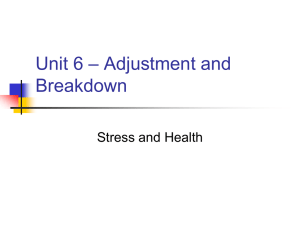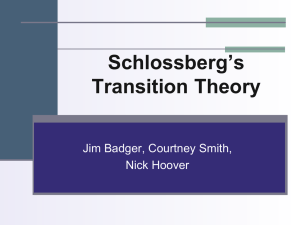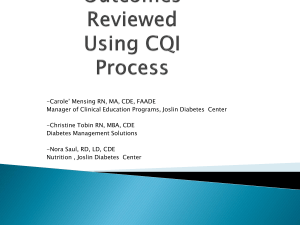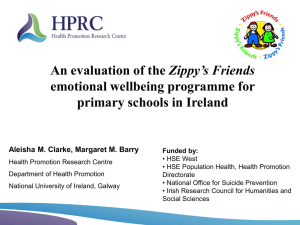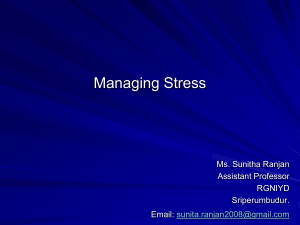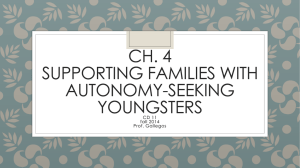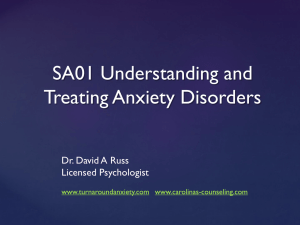Distress - Society of Critical Care Medicine
advertisement
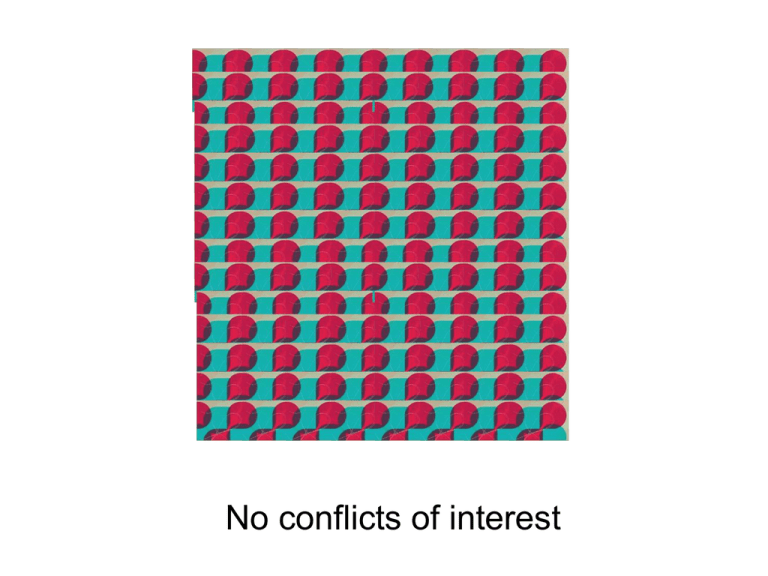
No conflicts of interest Please ask questions DukeProSPER.org Adaptive coping after critical illness: a novel mobile patient-centered intervention Christopher Cox Duke University Pulmonary, Critical Care, and Palliative Medicine Mike: 48yo with ARDS from pneumonia. Gets home—weak, PTSD. Why am I like this? Patient-centered care…dimensions & concepts Open information access Collaborative management Family & friends involved Non-medical & spiritual needs Respect for patient preferences Physical / emotional symptoms 1 Balint 1969 Picker Institute/Commonwealth 1993 Curtis, Rubenfeld, Angus, Herridge, Needham, Carson, Hopkins PCORI 2011 Patient-centered care…dimensions & concepts information access collaborative management family & friends involved non-medical & spiritual needs respect for patient preferences 1 physical / emotional symptoms 2 Balint 1969 Picker Institute/Commonwealth 1993 Curtis, Rubenfeld, Angus, Herridge, Needham, Carson, Hopkins PCORI 2011 Challenges of patient-centered outcomes Define, prioritize, measure, ask? How to engage patients in research? When you have a hammer…aligning patient interests & research capacity Patient – provider translator? Gabriel SE 2012 Past and current: the impact of critical illness is profound and persistent ADL difficulties 50-70% daily informal caregiving 50-75% not back to work 50% psych. distress 50-75% life savings lost 60% Herridge, Stelling, Covinsky, Carson, Nelson, Cox, Bienvenu, Needham, 1990s-2000s Psychological distress symptoms are serious among ICU survivors Distress = depression, anxiety, PTSD 40% saw a mental health provider 50% using psych meds after discharge Many patients describe in their own words: “People sometimes do not know what you go through. They think that because you are in one piece, everything is fine. But inside I’m all screwed up now.” Weinert 2006; Cox 2009; Bienvenu 2013 Psychological distress: difficult to prevent, complicated to treat Delusional memories Treatment (sedation, PaO2, glucose) Symptoms Social support Cognit ion Caregi ving needs Comorb idities & psych history Illness severity Communication Davydow 2011, Azoulay 2005, Bienvenu 2013 Trajectories of post-discharge health are complicated and tough to predict cancer chemo health status septic shock Trajectories of post-discharge health are complicated and tough to predict cancer depression, anxiety, PTSD chemo septic shock And other challenges… Heterogeneous patients Very disabled—hard to return to clinic Logistical challenges Transient and permanent disability Few targeted therapies Gabriel SE 2012 How can I get my life back? critical illness defining sense of self pervasive traumatic memories inability to cope with new disability Study 1 Cox 2009 patient-family relationship strain day to day impact of critical illness What is coping: thoughts and actions used to manage stress…not a passive process Stress emotional physical psychological etc + adaptive / constructive coping maladaptive / destructive coping Conceptual model of coping & distress Problems Common to ICU Survivors - Psychological distress - Barriers to post-discharge care for distress - Few treatment options perceived by patients Coping Frequency & Quality Self Efficacy Psychological Distress Quality of Life Study 2: Poor coping ability is common among ICU survivors Significant depression Patients (n=21) 12 (58%) Caregivers (n= 23) 5 (22%) Significant anxiety 14 (66%) 11 (48%) Significant PTSD symptoms 12 (58%) 7 (30%) Quality of life 70 (35, 75) 60 (29, 83) Poor coping, general 21 (100%) 23 (100%) Poor coping, global attributes 14 (66%) 12 (52%) Cox, Porter, Keefe, et al. 2012 Study 2: Maladaptive coping is correlated with psychological distress & QOL Infrequent coping r = 0.39 - 0.66 Poor QOL r = 0.30 - 0.75 r = 0.36 - 0.80 Anxiety r = 0.32 - 0.72 PTSD Depression Cox, Porter, Keefe, et al. 2012 Study 3: Can we develop a coping skills intervention that is feasible, acceptable, and shows promise? Development of coping skills intervention Evaluation of coping skills intervention Study 3: Can we develop a coping skills intervention that is feasible, acceptable, and shows promise? Cox, Porter, Keefe, et al. 2012 Coping and distress assessment Assessed for eligibility 34 patients 34 informal caregivers Excluded 6 patients didn't meet inclusions 4 patients died 2 caregivers refused 1 patient refused Enrolled & interviewed 6 weeks post-discharge 21 patients 23 informal caregivers Derivation of coping skills intervention Prospective evaluation of coping intervention Assessed for eligibility 16 patients 16 informal caregivers Excluded 4 patients didn't meet inclusions 2 caregivers refused 3 patients died Enrolled 7 patients 7 informal caregivers Interview 1 patients & caregivers ~2 weeks of arrival home HADS, PTSS, COPE Intervention 12 weekly coping skills sessions Interview 2 patients & caregivers ~1 week post-intervention HADS, PTSS, COPE acceptability Study 3: Individualization, selfmanagement, collaborative care Cox, White, Carson, Hough, Kahn, Porter, Keefe 2012 Study 3: Coping skills intervention elements for specific distress targets Day to day impact of critical illness Inability to cope with post-ICU disability problem solving activity-rest cycling Patientcaregiver relationship strain Critical illness defining sense of self behavioral rehearsal relaxation training communication techniques maintenance planning problem solving activity-rest cycling pervasive traumatic memories cognitive restructuring pleasant imagery How does coping training work in practice? Mrs. Edwards says main stressor is post-ICU physical disability. She also has troubling memories of the ICU. Session 1 starts with activity-rest cycling, focusing on activities of daily living that she values. She reviews the material in the guidebook and discusses it with her daughter. At Session 2, she is more confident in her ability to manage distress. The next topic most relevant to her distress about troubling memories is begun (cognitive restructuring). This strategy of personalization, self-management, and feedback continues through other phone sessions. Study 3: Coping skills training may reduce distress Figure 8: CST pilot results. CST resulted in reductions in HADS Cox, Porter, Keefe, al. 2012 (depression, anxiety) and PTSS (PTSD)et scores, as well as Study 3: Conceptual model validated: distress reduction correlates with enhanced self-efficacy & adaptive coping PSTD Depression Anxiety r = 0.50 - 0.80 Selfefficacy r = 0.40 - 0.76 Adaptive Coping Skills Cox, Porter, Keefe, et al. 2012 Study 3: Evaluation: coping skills program feasible & acceptable Current RCT: adaptive coping skills vs. education programs by phone & web Problems Common to ICU Survivors - Psychological distress Barriers to post-discharge care for distress Informational needs that are not addressed Few treatment options perceived by patients EP CST Informational Support Coping Frequency Self Efficacy Self Efficacy Psychological Distress Quality of Life Days at Home I can get back on track faster PS: challenges of patient-centered outcomes Define, prioritize, measure, ask? How to engage patients in research? When you have a hammer…aligning patient interests & research capacity Patient – provider translator? Gabriel SE 2012 What about the future of this and similar interventions? Choice & precision: Preference- and needsbased, individualizable treatment. Self-management: Self-pacing, logic-based content, non-professional interventionists, and feedback on effect Convenience & mobility: Balancing people (human but more expensive) with mobile devices (cheap, high tech, widely used). Future? Summary: coping skills training to reduce distress using patient-centered methodology DukeProSPER.org Questions for tech support? THANKS!

